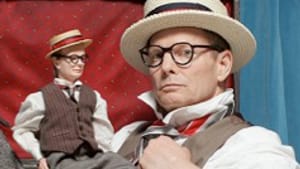Stay in the Loop
BSR publishes on a weekly schedule, with an email newsletter every Wednesday and Thursday morning. There’s no paywall, and subscribing is always free.
PTC's "The Happiness lecture' (2nd review)

When comedy defies explanation
STEVE COHEN
Bill Irwin’s The Happiness Lecture is an exhilarating experience— simultaneously a showcase for the comic actor’s extraordinary craft and a celebration of clowning with some excellent Philadelphia talent. It’s a performance art piece with imaginative flights of fancy and a strong narrative.
This structure is worth noting because the biggest running joke of the 90-minute experience is its lack of such a point. Jen Childs, wearing a red bulb on her nose and huge clown shoes, keeps urging Irwin, "C’mon, these people are waiting for a story. It’s time to tell a story."
His story is told with comic bits, dance, dream sequences and acrobatics. One thing it is not is a lecture. The title refers to a routine at a podium in which Irwin launches into a dissertation on his art. But don’t worry— that’s just a hook; there’s no sermonizing here.
Childs mocks the reputation of performing arts pieces for being pointless, but actually The Happiness Lecture has a clear through-line. Irwin shows us how his life is consumed by a desire to make others happy and how sometimes that involves struggle and nightmares, which he relives on stage.
Those of us who enjoyed Irwin’s Broadway comedy revue Fool Moon in the 1990s, as well as other Irwin vehicles, knew what to expect, but not fully. It’s a welcome recapsulation of his physical shticks, such as shrinking his body, climbing into a box and disappearing, and a variety of rubbery movements. A welcome expansion in this play is the vivid imagery of Irwin’s dreams.
The retractable spaghetti strand
Among the highlights are Irwin’s inability to control modern gadgets, and his wordplay: At one point he explains that a remote control is digital as he grabs his fingers, his digits, to make sure they are unharmed.
The funniest moments are Irwin’s appearance on a TV monitor, where the onscreen Irwin interacts with the real Irwin, and a sequence in which Irwin and his cohorts play with spaghetti. Irwin stretches the spaghetti into one long strand as he goes into the audience, running through the aisles and up and around the balcony. Then he releases the strand and it snaps back, retracing its path for a socko ending. I don’t know how he makes this work, and I don’t want to. This is one aspect of the art of comedic performance that is better when it is unexplained. And I believe that’s Irwin’s point.
Irwin also uses what theater-folks call deconstruction– the stepping back and observation of what’s happening on stage during the course of the play– to lend an additional dimension to the evening.
A few dull spots
There are just a couple of dull spots: an overlong story about prehistoric men Ig and Og; a troupe of hooded figures who spend too much stage time before making their point. The presence of these Ninja or Kung Fu figures isn’t woven into an otherwise logical explication.
While Irwin shows us what comedy is all about, Lee Ann Etzold tries to explain it to us. In case you don’t know what this Philadelphia writer-actor looks like– her creative work has taken place mostly in front of intimate audiences at Fringe and New Paradise Laboratories productions-- I won’t tell you how and where she appears in The Happiness Lecture. Let that be a happy surprise.
The last time I saw Irwin, he and I were members of a small audience for the workshop of an experimental piece created by dancer Nichole Canuso at the 2007 Fringe Festival, Wandering Alice. Irwin clearly was impressed by Canuso, and he uses her on stage in The Happiness Lecture. Local puppet master Aaron Cromie has created two miniature Bill Irwins who appear in little boxes on stage while the big Irwin takes a momentary breather.
Another multi-faceted local theater personality, Jorge Cousineau, contributes his set, sound and lighting design.
To read a response, click here.
To read another review by Bob Cronin, click here.
STEVE COHEN
Bill Irwin’s The Happiness Lecture is an exhilarating experience— simultaneously a showcase for the comic actor’s extraordinary craft and a celebration of clowning with some excellent Philadelphia talent. It’s a performance art piece with imaginative flights of fancy and a strong narrative.
This structure is worth noting because the biggest running joke of the 90-minute experience is its lack of such a point. Jen Childs, wearing a red bulb on her nose and huge clown shoes, keeps urging Irwin, "C’mon, these people are waiting for a story. It’s time to tell a story."
His story is told with comic bits, dance, dream sequences and acrobatics. One thing it is not is a lecture. The title refers to a routine at a podium in which Irwin launches into a dissertation on his art. But don’t worry— that’s just a hook; there’s no sermonizing here.
Childs mocks the reputation of performing arts pieces for being pointless, but actually The Happiness Lecture has a clear through-line. Irwin shows us how his life is consumed by a desire to make others happy and how sometimes that involves struggle and nightmares, which he relives on stage.
Those of us who enjoyed Irwin’s Broadway comedy revue Fool Moon in the 1990s, as well as other Irwin vehicles, knew what to expect, but not fully. It’s a welcome recapsulation of his physical shticks, such as shrinking his body, climbing into a box and disappearing, and a variety of rubbery movements. A welcome expansion in this play is the vivid imagery of Irwin’s dreams.
The retractable spaghetti strand
Among the highlights are Irwin’s inability to control modern gadgets, and his wordplay: At one point he explains that a remote control is digital as he grabs his fingers, his digits, to make sure they are unharmed.
The funniest moments are Irwin’s appearance on a TV monitor, where the onscreen Irwin interacts with the real Irwin, and a sequence in which Irwin and his cohorts play with spaghetti. Irwin stretches the spaghetti into one long strand as he goes into the audience, running through the aisles and up and around the balcony. Then he releases the strand and it snaps back, retracing its path for a socko ending. I don’t know how he makes this work, and I don’t want to. This is one aspect of the art of comedic performance that is better when it is unexplained. And I believe that’s Irwin’s point.
Irwin also uses what theater-folks call deconstruction– the stepping back and observation of what’s happening on stage during the course of the play– to lend an additional dimension to the evening.
A few dull spots
There are just a couple of dull spots: an overlong story about prehistoric men Ig and Og; a troupe of hooded figures who spend too much stage time before making their point. The presence of these Ninja or Kung Fu figures isn’t woven into an otherwise logical explication.
While Irwin shows us what comedy is all about, Lee Ann Etzold tries to explain it to us. In case you don’t know what this Philadelphia writer-actor looks like– her creative work has taken place mostly in front of intimate audiences at Fringe and New Paradise Laboratories productions-- I won’t tell you how and where she appears in The Happiness Lecture. Let that be a happy surprise.
The last time I saw Irwin, he and I were members of a small audience for the workshop of an experimental piece created by dancer Nichole Canuso at the 2007 Fringe Festival, Wandering Alice. Irwin clearly was impressed by Canuso, and he uses her on stage in The Happiness Lecture. Local puppet master Aaron Cromie has created two miniature Bill Irwins who appear in little boxes on stage while the big Irwin takes a momentary breather.
Another multi-faceted local theater personality, Jorge Cousineau, contributes his set, sound and lighting design.
To read a response, click here.
To read another review by Bob Cronin, click here.
Sign up for our newsletter
All of the week's new articles, all in one place. Sign up for the free weekly BSR newsletters, and don't miss a conversation.

 Steve Cohen
Steve Cohen